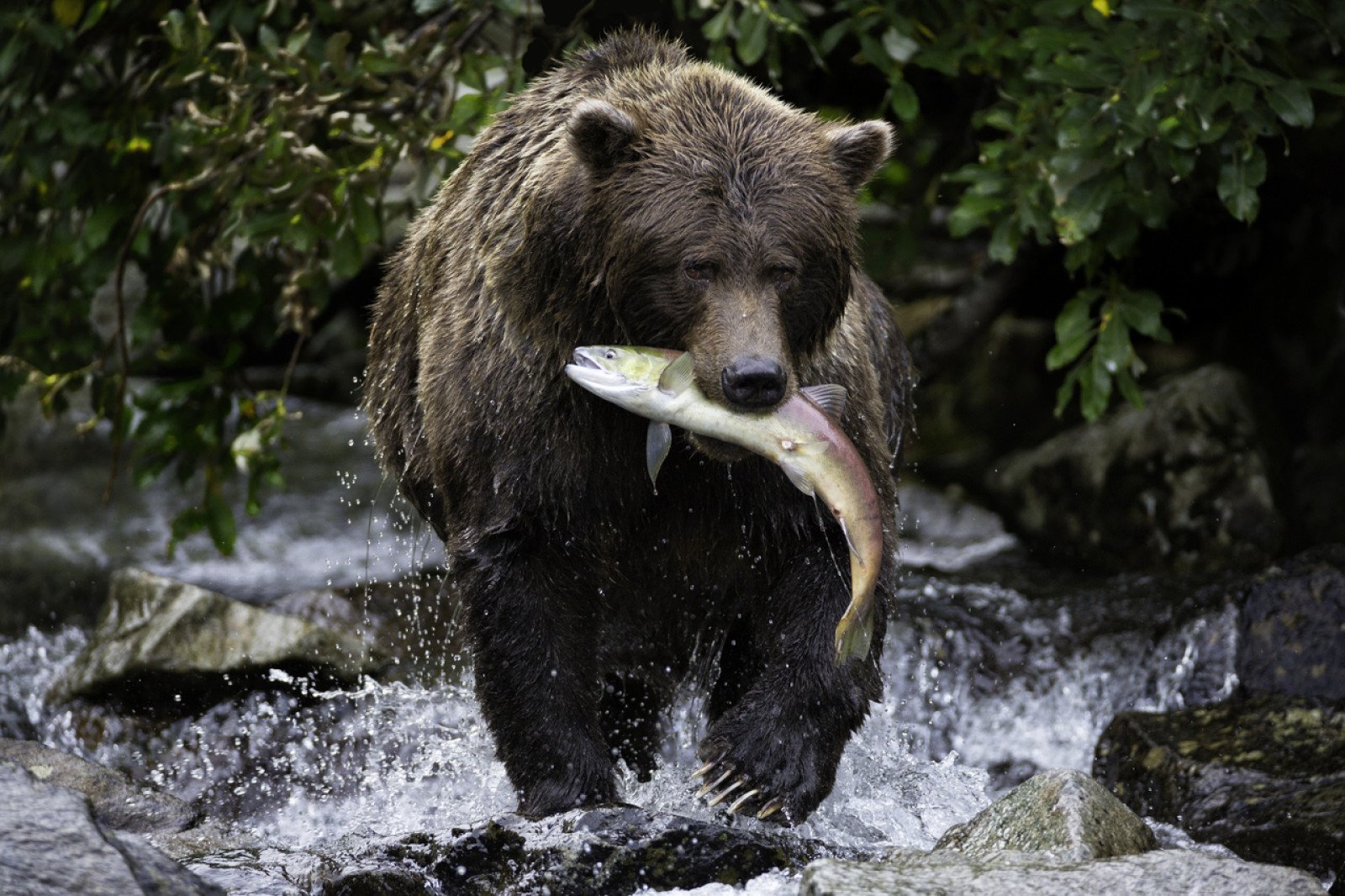
Overview
Students discover Indigenous Peoples’ understanding of how water connects us and the importance of water to all living things.
Instructions
What you'll need
- "The importance of water" slides
- Digital projector and screen
- Begin the activity by opening up "The importance of water" slides and showing slide 2. Invite your students to make a decision: how important is water to all living things? Guide students in using the rating scale shown on the slide to make their decision.
- Show slide 3 and ask your students, “What does water provide animals?” Record their ideas for use later in this activity. Students might suggest ideas like water is a home, water is a drink, water cools them off, water keeps them clean, and so on).
- Show slide 4 and ask your students, “How important is water to a moose?” Guide students in using the rating scale shown on the slide to make their decision. Encourage them to use ideas from the class list to support their decision.
- Show slides 5 and 6 and read Indigenous Peoples' beliefs about water. Play the "Honouring water" video as an example of how the Leq'a:mel Nation in British Columbia honours water.
- Briefly explain to your students that their challenge in this activity is to decide how important water is to living creatures.
- Display slides 7-12 and ask your students to first use clues in the images to identify the living creatures. After students correctly identify each creature, ask them to use the rating scale to decide how important water is to the creature. Remind students to use ideas from the class list to support their decisions.
- Show slide 13 and ask your students, “How important is water to…?” After students suggest answers such as “humans,” “children,” or “families,” ask them to use the rating scale to decide how important water is. Remind students to use ideas from the class list to support their decisions.
- Display slide 14 and invite your students to make a decision: how important is water to all living things?
- To conclude the activity, ask your students what they learned about the importance of water to living creatures. If water provides what all living things need, how should we treat it?
Modify or extend this activity
Extension
- Create a collaborative class mural or display to show the importance of water to living things. Build a border for the mural with sentence strips of students’ ideas of ways they can better take care of water.
Curriculum Fit
Kindergarten Science
Big idea
- Plants and animals have observable features.
Content
- Basic needs of plants and animals
- Adaptations of local plants and animals
Curricular competencies
Questioning and predicting
- Ask simple questions about familiar objects
Processing and analyzing data and information
- Recognize First Peoples stories, songs, and art, as ways to share knowledge
Grade 1 Science
Big idea
- Living things have features and behaviours that help them survive in their environment.
Content
- Classification of living and non-living things
- Names of local plants and animals
- Behavioural adaptations of animals in the local environment
- Local First Peoples knowledge of the landscape, plants and animals
Curricular competencies
Questioning and predicting
- Demonstrate curiosity and a sense of wonder about the world
- Observe objects and events in familiar contexts
- Ask questions about familiar objects and events
Processing and analyzing data and information
- Recognize First Peoples stories, songs, and art, as ways to share knowledge
- Sort and classify data and information using drawings, pictographs and provided tables
Applying and innovating
- Transfer and apply learning to new situations
Communicating
- Communicate observations and ideas using oral or written language, drawing or role-play
Assessments
Assess students’ ability to:
- Ask simple questions about familiar objects
- Transfer and apply learning to new situations
- Use visual clues to make accurate observations and plausible inferences
- Communicate observations and ideas using oral language
Teaching Notes
Indigenous understanding of water
- Mother Earth teaches what we need to know to take care of her and all her children.
- Indigenous Peoples are caretakers of Mother Earth and realize and respect her gifts of water, air and fire.
- Indigenous Peoples have a special relationship with the earth and all living things in it.
- This relationship is based on a spiritual connection to Mother Earth that guided indigenous peoples to practice reverence, humility and reciprocity.
- It is also based on the subsistence needs and values extending back thousands of years.
- Hunting, gathering, and fishing to secure food includes harvesting food for self, family, the elderly, widows, the community, and for ceremonial purposes.
- Everything is taken and used with the understanding that we take only what we need, and we must use great care and be aware of how we take and how much of it so that future generations will not be put in danger.
Learn more about honouring Earth from the Assembly of First Nations.
Children and water
- Children want to be with water, learn from water and watery places and return to water.
- Playing in the rain offers new experiences and perspectives; water is also a gift for the trees, birds and the river.
- Children are drawn to stick and water play.
- They throw stones back to the water, jump in puddles.
- They notice turtles on logs, investigate velvety green mosses revived by spring rains and make up stories about muddy animal tracks.
- They like drinking wild peppermint tea outdoors, collecting water for the vegetable garden and say that water nestled in flower petals are the drinking cups for bees and birds.
- We learn the ways of the ones who take care of us, so we may take care of them.
- With Indigenous knowledge holders and storytellers, we walk together and learn that each element, plant and animal not only has a name but a spirit, a story, a gift and a responsibility, as do we humans.
- Nature is not just seen as a resource or commodity, but something that engages mind, body, heart and spirit together.
- Being respectful of and having respect for water is important.
- Experiencing and connecting to water in its natural environment is essential for children to develop confidence.
- Building a healthy relationship not only with the environment, but with all those who call the land home is crucial.
For more information about children and water, please read this article titled: Children make connections to Aki (Earth) through Anishinaabe teachings
How this activity was developed
These materials were created with guidance from Indigenous educators, subject matter experts and thought leaders to help draw upon important teachings, learnings, and Indigenous perspectives.
For centuries, the traditional western view of water has often been focused on its value as a resource. Indigenous people have a unique relationship with the waters of British Columbia. Since time immemorial, water has played a sacred role and is seen as a living entity. How water is used must be carefully considered with a view towards not just the immediate need and impact, but the needs and perspectives of generations to follow.
We are dedicated to deep listening and respectfully highlighting Indigenous ways of knowing in the materials we provide B.C. educators. If you have any feedback for us on these activities, or suggestions for others, please email schools@bchydro.com. We would love to hear from you.
About the artist
The design of the worksheets in this activity was a collaborative effort with Indigenous artist Kelli Clifton. Kelli Clifton was born and raised in Prince Rupert, British Columbia and is Gitga’at from the community of Hartley Bay. Clifton is interested in using her artwork as a form of storytelling—especially in relation to her Ts’msyen language (Sm’algyax), her coastal upbringing and her experiences as an Indigenous woman. Clifton currently lives in her home community where she continues to practice her art and teaches Sm’algyax at a local high school. Learn more about Clifton's art on her Facebook page.
BC Hydro’s commitment to reconciliation
BC Hydro exists to serve British Columbians by providing clean, reliable and affordable electricity. We recognize that maintaining and developing the system has impacts on the lives and interests of Indigenous Peoples. To support our move towards true and lasting reconciliation, BC Hydro will acknowledge past wrongs, listen to Indigenous perspectives and seek shared understanding with First Nations communities and governments.
Learn more about our Statement of Indigenous Principles.







